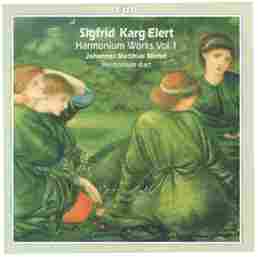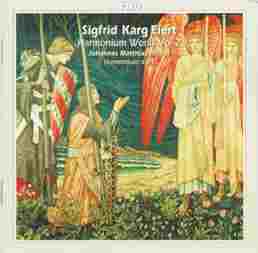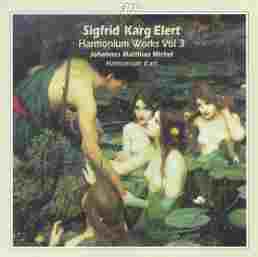
Program:
Fantasy and Fugue, Op. 39 in D Major
Impressions: 12 Pieces for Harmonium, Op. 102
Two Tone Poems (Orchestral Studies), Op. 70
Ein Jagdnovellette
Totentanz
All compositions by Sigfrid Karg-Elert (1877-1933)
total time: 62:43
Released in 1997
Review date: January 2000

Lohengrin
Tristan und Isolde
G tterd mmerung
Siegfried
Die Meistersinger von N rnberg
Rienzi
Der Fliegende Holl nder
Tannh user
Parsifal
total time: 72:05
Released in 1998
Review date: January 2000

Miniaturen, Op. 9
Three sonatinas, Op. 14
Sonatina in G Major
Sonatina in E Minor
Sonatina in A Minor
total time: 72:59
Released in 1998
Review date: January 2000
Label:
Classic Produktion Osnabr ck (CPO 999 522-2)
Order from: CPO-Musikproduktions GmbH
Postfach 13 29
(L becker Str. 9)
D-49111 Georgsmarienh tte
Germany
Telefon: 0 54 01 / 85 12 75
Telefax: 0 54 01 / 85 12 99
Review by Henry Doktorski:
I must confess that this CD was my first exposure to the kunstharmonium, or harmonium d'art. I have heard and played many American-made harmoniums, including historical instruments, and, although I enjoyed their sound, I was unimpressed with their musical abilities. The instruments were simply not very exciting.However, the harmonium d'art -- built by the Victor Mustel Company of Paris in 1913 -- heard on this recording is a very different instrument. It has an incredibly wide dynamic range, beginning at ppp and continuing through fff. The crescendo is powerful and abrupt, like a bayan or accordion, and the range of tonal colors and pitch range is fantastic. For the longest time I thought the Russian bayan was the Rolls Royce of free-reed instruments. Now after hearing this recording, I am convinced that this title belongs to the harmonium d'art.
Perhaps a word of explanation regarding the history of the harmonium is in order. Around 1800 German and French instrument builders began experimenting and developing keyboard instruments with free metal reeds, allowing for the smooth dynamics and the realization of the espressivo. (Pipe organs do not have the capacity for dynamic variation, except with the use of shutters to open and close the cabinet.)
In 1819 Gabriel Joseph Greni termed one instrument the orgue expressif, a name still in use today. A. F. Debain and Victor Mustel were responsible for most of the innovations in construction; they introduced the term harmonium around 1840.
These innovations included: 1) an expression stop which shut off the wind reservoir and made it possible to control the wind pressure with the feet alone for the production of continuous dynamic changes, 2) vibrato, 3) accents, 4) percussion action and 5) a small hammer mechanism.
In 1856 Jacob Estey began building a harmonium based on the suction principle; an instrument cheaper and easier to produce. On the downside, this instrument did not have as much sound power or dynamic nuance as the compression-type instruments and were consequently not suitable for very expressive music. This is the type of instrument which became popular in America (which I found dull and boring).
The kunstharmonium, or harmonium d'art was the greatest of harmoniums. It had the following basic stops which were split between the two halves of the keyboard:
flute / cor anglais 8'
clarinette /bourdon 16'
fifre / clairon 4'
hautbois / basson 8'
Along with a percussion mechanism for stop No. 1, the harmonium d'art called for a prolongement (sustainer) for the bass octave, pneumatic swell (forte espressif) and m taphone units for the modification of tone colors, an expression stop, and a double expression, an air-pressure division operated by a knee lever and making it possible to play a full-sounding chord in the bass half with all the stops more quietly than a descant melody with a single stop and voice.
If that was not enough, the bass also had a harpe olienne 2' tremulant, and the descant had additions in the form of a musette 16', voix c leste 16' tremulant, barytone 32', and harpe olienne 8' tremulant. Talk about a magnificent instrument! Truly the harmonium d'art is the most sophisticated and versatile free-reed instrument ever created.
This CD by Johannes Matthias Michel gives a wonderful sampling of one of (if not THE) greatest composer(s) to write for the harmonium. Siegfried Theodor Karg was born in 1877 in Oberndorf am Neckar, Germany and studied at the Conservatory of Liepzig. When he became a freelance composer in 1903 he changed his name to Sigrid Karg-Elert. In 1904 he met Carl Simon, a Berlin publisher and harmonium specialist who inspired him to write for the harmonium, especially for the Kunstharmonium, the harmonium d'art. Karg-Elert's extensive harmonium oeuvre eventually included two sonatas, three sonatinas, and cycles, as well as several didactic works: an elementary course, a two-volume registration course and collections of tudes.
Every single piece on these three CDs -- totaling 207 minutes -- is, in my opinion, a jewel of post-romantic composition. Karg-Elert is by no means an unknown composer, in fact, today he is regarded as the art nouveau composer par excellence.
His original works are interesting and accessible for listeners and betray the composer's fascination with contrasting tone colors. Karg-Elert was very specific about the registrations of his pieces. In the preface to Impressions, Opus 102, he wrote, "The present twelve impressions require a very subtly considered coloration. In some cases the registration serves for the underscoring of the architectonic-graphic form; in other cases colors and color complexes become direct expressive means... One should rate the exact registration of coloristically conceived original harmonium works as synonymous with the authentic instrumentation of original orchestral works. Color corrections are out of place."
Karg-Elert wrote about the instrument he loved, "In the kunstharmonium. . . I found the fulfillment of a long-desired idea: orchestral faithfulness, extraordinarily great capacity of expression to be distributed among groups, voices and single tones; undreamed of wealth of technical playing potential which hardly is really inferior to virtuoso piano playing, surprising originality, etc. This instrument is not an organ or orchestra copy; it is in itself, in its very nature, independent."
Karg-Elert regarded the harmonium d'art as an instrument "that a demanding artist need not be ashamed to advocate." Truly this is a lesson to be learned for all advocates of the free-reed instruments.
These three CDs by Johannes Matthias Michel fulfill my requirements for
top quality recordings: 1) superb music (the compositions of Karg-Elert
are extraordinarily superb), 2) superb performance, and 3) superb
recording engineering. In my opinion, this collection is a MUST HAVE
for any classical free-reed connoisseur. I ask you to listen to these
magnificent compositions of Karg-Elert performed by
Johannes Matthias Michel was born in 1962 in Stuttgart. He studied piano
and church music and graduated from the School of Music in Stuttgart.
Michel performs widely in concerts on the organ and harmonium in addition
to being president of the Karg-Elert Society, a composer and editor of
choir and organ music and teacher of a class in artistic and liturgical
organ playing at the School for Church Music in Heidelberg. He presently
serves as director of music at the prestigious Mannheim
Christuskirche. CD booklet notes by Werner Straube and J.M. Michel
are written in German, English and French.
About The Free-Reed
Review Invitation to Contributors / Submission
Guidelines Back to The Free-Reed
ReviewContents Page
Back to The Classical Free-Reed,
Inc. Homepage